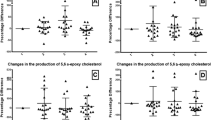Zusammenfassung
Die temporäre Okklusion des Ligamentum hepatoduodenale bei chirurgischen Eingriffen an der Leber (Pringle Maneuver) verursacht die Störung der Organfunktion bis hin zu komplettem Leberfunktionsversagen. Der durch die Ischämie und die nachfolgende Reperfusion/Reoxygenation verursachte Gewebeschaden ist vornehmlich durch die Beeinträchtigung der Mikrozirkulation mit Perfusionsstörungen in Sinusoiden (Leberkapillaren) sowie durch die Aktivierung von Leukozyten und deren Interaktion mit dem mikrovaskulären Endothel charakterisiert [1, 2]. Verschiedene Trigger-Mechanismen, einschließlich die Bildung und Freisetzung von reaktiven Sauerstoffmetaboliten (Sauerstoffradikale) über das Xanthin Dehydrogenase/Xanthin Oxidase System [3], werden als ursächliche Faktoren für die postischämische Störung der Mikrozirkulation diskutiert. Ziel der Studie war, mit Hilfe der intravitalen Fluoreszenzmikroskopie die Bedeutung des Superoxid Anion Radikals sowie dessen Quelle Xanthin Oxidase für die Manifestation des mikrovaskulären Reperfusionsschadens der Leber nach temporärer Okklusion des Ligamentum hepatoduodenale quantitativ zu analysieren.
Access this chapter
Tax calculation will be finalised at checkout
Purchases are for personal use only
Preview
Unable to display preview. Download preview PDF.
Similar content being viewed by others
Literatur
Vollmar B, Glasz J, Post S, Leiderer R, Menger MD (1994) Hepatic microcirculatory perfusion failure is a determinant for liver dysfunction in warm ischemia-reperfusion. Am J Pathol 145: 1421–1431
Vollmar B, Menger MD, Glasz J, Leiderer R, Messmer K (1994) Impact of leukocyte-endothelial cell interaction in hepatic ischemia/reperfusion injury. Am J Physiol 267: G786–G793
Granger DN (1988) Role of xanthine oxidase and granulocytes in ischemia-reperfusion injury. Am J Physiol 255: H1269–H1275
Friedl HP, Smith DJ, Till GO, Thomson PD, Louis DS, Ward PA (1990) Ischemia-reperfusion in humans. Appearance of xanthine oxidase activity. Am J Pathol 136: 491–495
Weiss SJ (1980) The role of Superoxide in the destruction of erythrocyte targets by human neu- trophils. J Biol Chem 255: 9912–9917
Menger MD, Steiner D, Messmer K (1992) Microvascular ischemia-reperfusion injury in striated muscle: significance of “no-reflow” Am J Physiol 263: H1892–H1900
Menger MD, Pelikan S, Steiner D, Messmer K (1992) Microvascular ischemia-reperfusion injury in striated muscle: significance of “reflow-paradox”. Am J Physiol 263: Hl901–H1906
Author information
Authors and Affiliations
Editor information
Editors and Affiliations
Rights and permissions
Copyright information
© 1995 Springer-Verlag Berlin Heidelberg
About this paper
Cite this paper
Müller, M.J., Friedl, HP., Vollmar, B., Menger, M.D. (1995). Xanthin Oxidase und Superoxid Radikale vermitteln den mikrovaskulären Reperfusionsschaden der Leber nach temporärer Okklusion des Ligamentum hepatoduodenale. In: Beger, H.G., Hierholzer, G., Seifert, J., Hartel, W. (eds) Chirurgisches Forum ’95 für experimentelle und klinische Forschung. Langenbecks Archiv für Chirurgie, vol 95. Springer, Berlin, Heidelberg. https://doi.org/10.1007/978-3-642-79621-0_86
Download citation
DOI: https://doi.org/10.1007/978-3-642-79621-0_86
Publisher Name: Springer, Berlin, Heidelberg
Print ISBN: 978-3-540-59036-1
Online ISBN: 978-3-642-79621-0
eBook Packages: Springer Book Archive




